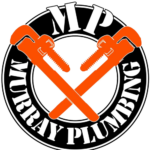A slow-draining sink can be frustrating. It’s a common problem that can occur for various reasons. Whether it’s in your kitchen or bathroom, a slow-draining sink can lead to clogs, bad smells, and even water damage if left untreated. In this post, we will explain how to fix a slow-draining sink and how Murray Plumbing Inc. can help.
Common Causes of a Slow Draining Sink
Before diving into solutions, it’s important to understand what causes a sink to drain slowly. The most common causes include:
1. Clogs
The most common cause of a slow-draining sink is a clog. Food, hair, soap scum, grease, and other debris can accumulate in your pipes, causing a blockage. This blockage slows down the flow of water, leading to a slow drain.
2. Buildup of Soap Scum and Grease
In kitchen sinks, soap scum and grease from dishes can build up over time. This creates a sticky residue inside the pipes that slows the water’s flow.
3. Pipe Problems
If your pipes are old, corroded, or misaligned, they can cause slow drainage. Damaged pipes may develop holes or cracks, causing water to move slowly through them.
4. Ventilation Issues
Your sink needs proper ventilation to drain efficiently. If the vent pipe is blocked or damaged, it can cause water to drain slowly, or even lead to gurgling sounds when you drain water.
5. Tree Root Infiltration
In some cases, tree roots can grow into the plumbing system, blocking or restricting water flow. While this is more common in outdoor pipes, it can affect indoor sinks if the roots penetrate the system.
How to Fix a Slow Draining Sink
Now that we know the common causes, let’s look at some ways to fix a slow-draining sink. These solutions can help clear minor blockages and improve the flow of water.
1. Boiling Water
Sometimes, a slow drain is caused by grease or soap buildup. Boiling water can help break down these substances and clear the pipe. Here’s how to do it:
- Boil a pot of water.
- Carefully pour the boiling water down the drain in stages. Wait a few seconds between each pour.
- Repeat the process until the water drains properly.
This method works well for minor clogs caused by soap or grease. However, if the problem persists, you may need to try other methods.
2. Plunger
A plunger is a simple and effective tool for clearing blockages. To use a plunger on your sink:
- Fill the sink with enough water to cover the plunger’s rubber cup.
- Place the plunger over the drain and create a tight seal.
- Push the plunger up and down rapidly, using strong force. This will create suction and may dislodge the clog.
- Remove the plunger and check if the water drains more quickly.
If the water drains faster after plunging, you’ve likely cleared a minor blockage. If not, proceed to other methods.
3. Baking Soda and Vinegar
Baking soda and vinegar create a chemical reaction that can help break down grease and debris. To use this method:
- Pour 1/2 cup of baking soda down the drain.
- Follow with 1/2 cup of white vinegar.
- Cover the drain with a plug or cloth and let the mixture sit for 10-15 minutes.
- After the waiting period, pour hot water down the drain to flush out the mixture.
This method is effective for clearing clogs caused by soap, grease, or minor debris.
4. Drain Snake
A drain snake is a flexible tool that can reach deep into the pipes to clear stubborn blockages. To use a drain snake:
- Insert the end of the snake into the drain.
- Turn the handle to push the snake down the pipe.
- When you feel resistance, turn the snake to grab and break up the clog.
- Slowly pull the snake out while continuing to turn it.
- Once removed, run hot water down the drain to clear any remaining debris.
A drain snake can clear more difficult blockages that a plunger or boiling water might not fix. If the clog is deep within the pipe, this tool is often the best solution.
5. Remove and Clean the Trap
The trap is the curved pipe beneath the sink that holds water and prevents sewer gases from entering your home. Over time, debris can accumulate in the trap, causing slow drainage. To clean the trap:
- Place a bucket under the trap to catch any water.
- Use a wrench to unscrew the nuts on both ends of the trap.
- Remove the trap and clean it out thoroughly.
- Reassemble the trap and check if the water drains properly.
Cleaning the trap is a good option if the clog is located near the drain opening.
6. Use a Plumbing Auger
If you still have a slow drain after trying the methods above, you may need to use a plumbing auger, also known as a drain auger. This tool is more powerful than a drain snake and can break up tough clogs deeper in the pipes. If you’re unsure how to use one, it’s best to call a professional plumber.
7. Check for Venting Issues
If none of the above methods work, the issue might be related to your plumbing vent. Vent pipes allow air to flow into the plumbing system, helping the water drain properly. If the vent is blocked or damaged, it can cause slow drainage. A professional plumber can inspect the vent and make any necessary repairs.
How Murray Plumbing Inc. Can Help
While you can try several methods to fix a slow-draining sink, some problems may require the expertise of a professional plumber. Murray Plumbing Inc. can help in the following ways:
1. Diagnosing the Problem
If you’ve tried the DIY methods and the problem persists, our team can help diagnose the issue. We use advanced tools like video inspection cameras to see inside your pipes and find the cause of the blockage. This helps us quickly identify and fix the issue.
2. Clearing Stubborn Clogs
If your sink is still draining slowly after multiple attempts to fix it, we have the right tools and experience to clear even the toughest clogs. Our drain cleaning services include using drain snakes, augers, and hydro-jetting to clear blockages safely and effectively.
3. Pipe Repair and Replacement
If your slow-draining sink is caused by damaged or corroded pipes, we can repair or replace the affected pipes. Our plumbers are skilled at repairing all types of pipes, including PVC, copper, and galvanized steel. We’ll make sure your plumbing system is working properly to prevent future issues.
4. Preventing Future Clogs
Once we fix your slow-draining sink, we can offer advice on how to prevent clogs in the future. This includes tips on what should and shouldn’t go down the drain, as well as regular maintenance to keep your plumbing system running smoothly.
5. Emergency Services
If your sink is draining slowly during an emergency, Murray Plumbing Inc. offers 24/7 emergency plumbing services. We are always ready to help, no matter the time of day or night.
How to Prevent Future Slow Drains
To keep your sink draining smoothly, here are a few simple tips to follow:
- Avoid pouring grease down the drain. Grease can solidify in the pipes, leading to clogs.
- Use a drain cover. A drain cover can catch hair and debris, preventing them from going down the drain.
- Regularly clean your drains. Use a mixture of baking soda and vinegar to clean your drains once a month.
- Be mindful of what you put down the drain. Avoid flushing food scraps, hair, or non-dissolvable items.
Conclusion
A slow-draining sink is often caused by a clog or buildup in the pipes. There are several methods you can try to fix the issue, including boiling water, using a plunger, or applying baking soda and vinegar. However, if these methods don’t work, or if the problem is more severe, Murray Plumbing Inc. can help. We offer professional diagnosis, clog removal, pipe repair, and preventative maintenance to ensure your plumbing runs smoothly. Contact us today to schedule a service!



